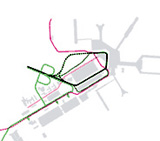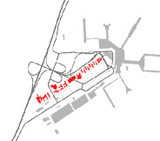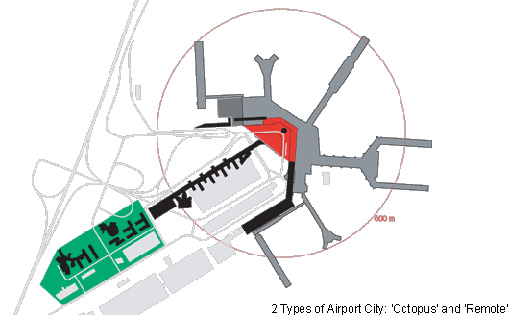client: municipality of Haarlemmermeer, Netherlands
team: Güller Güller architecture urbanism
With this project, the municipality of Haarlemmermeer and Schiphol Airport got a
strategic document for the spatial quality of Schiphol Airport City and for their
mutual co-operation in the further development of this asset. The report was
reproduced in 150 copies, and for all affected parties and institutions it became
the starting point for the future elaboration of their own development strategies
related to the (landside) development of the airport. This includes e.g. the 'General
Vision for the Future of Haarlemmermeer' (toekomstvisie Haarlemmermeer) or the
'Airport Development Plan ADP' of the airport operator.
Airport Cities
The development of Airport Cities has set off all over Europe in the last 10 years.
Schiphol Airport City is one of the most ambitious 'urban developments' on airports,
but seems to be built on rather instable political foundations.
In the 1980s, the 'Airport City' concept was developed as a marketing concept for the
terminals: the stay of passengers should be as convenient as possible, and the income
from shops in the terminals was to complement the income from airport taxes and
parking fees. Since that time, the concept has been extended by the Schiphol Group to
become the guiding principle for all spatial development on the airport's landside.
The goal was to optimally exploit the potentials around the exccellent traffic node.
This has recently led to an abstract rather than pragmatic conflict between local
authorities and the airport regarding the image, the necessity and the benefits of
an Airport City.
Distribution of responsibilities
Schiphol has always been an enclave within Haarlemmermeer. The responsibility for
planning the airport area was not with the muinicipality, but with the airport
itself and thus indirectly with the Dutch state. This system has been challenged in
the last few years, amongst others in view of a privatisation of the airport. The
municipality wants to overcome its role of spectator and take more influence on the
development of the Airport City. The question is how to distribute the
responsibilities and how to co-ordinate processes between airport and municipality
in the future.
Haarlemmermeer wants to tackle this challenge now by replacing the old but still
actual Schiphol masterplan of 1977 (!). This masterplan formed an overly big frame
for landside developments. At the same time, the future spatial development policy
of Haarlemmermeer is being revised. Within it, the aiprort's landside developments
shall appear more and more prominently.
Airport City is a hybrid development
With the step from a first generation Airport City (1990-2005) to a second generation
(after 2005), a critical mass is reached. Airport City can no longer happen solely
under the direction of the airport: municipality and airport are ever more dependent
on each other. The project 'Spatial quality of Schiphol Airport City' shows that a
concrete discussion of the specifical identity and urban quality of Schiphol Airport
City is urgent.
The conditions for efficiently planning and developing an Airport City must not be
underestimated. Airport planning has become ever more complex. An airport is no
longer a mere traffic machine. But an Airport City is also not just an urban
development. Airport City is per definition based on the coexistence of city and
airport. An Airport City is a hybrid development, a task for which there are as
yet close to no conceptual frameworks.
Criteria of spatial quality
An airport can therefore not be looked at with the same quality criteria as a
business park development. The step towards intensifying the land-use in Schiphol
Centrum must come along with a new vision on the type of 'urban area' one wants to
achieve in this location. New standards for the spatial quality of an Airport City
are required. As yet, only the business and marketing strategies for Airport Cities
seem to be far developed. On the other hand, the municipality needs to come up with
alternatives to a pure 'image-quality-plan' - an Airport City has no reference
images to rely on.
On the basis of an analysis of the current qualities, chances and weaknesses of the
developments in Schiphol Centrum, and through a comparison with outstanding Airport
Cities at other European airports, a series of 10 quality criteria (a kind of an
action plan) were worked out for the development and control of the second generation
Airport City at Schiphol. The criteria form a basis for a strategic discussion of
the spatial development of Schiphol Centrum and for testing the development plans
and realisation.
4 strategies for a joint venture
At the operational heart of the study there are four strategies for a co-operative
process between airport and municipality: different suggestions for a joint venture
for the further development of the Airport City and for the corresponding roles of
the two parties within the planning process and quality control. The strategies
sketch prototypical ways of how and by whom spatial quality can be guaranteed during
the development process. They are linked to the current process structure and to the
experiences made with Airport City developments internationally. The usual
instruments of local authorities are lacking efficiency on this special location:
today's static distribution of roles - the airport plans, the municipality tests on
the basis of legal frameworks - must be overcome with a flexible monitoring of the
spatial developments, on the basis of specific agreements between the two parties.
In some cases, the municipality is very much involved, in others the airport has the
lead.
Efficient and operational
The project has had a major spin-off. Whereas until now the airport and the
municipality were standing back to back to each other, a common agenda has now been
formed on the top-levels (management of Schiphol Group, and municipal council of
Haarlemmermeer) on the basis of this project. It outlines the further co-operation
process in formulating a conceptual framework for the landside developments at the
airport. This is not only about the identity of the Airport City, but just as much
about the identity of Haarlemmermeer as an airport municipality, about a common
vision about the area between airport and municipality and about the further
development of the Airport City itself.
This project has no 'sexy looks' per se. But, it has an enormous operational value
for the involved parties who are trying to tackle one of the most challenging urban
development tasks of today.
Publication available at:
Dienst RWE, Gemeente Haarlemmermeer

-
 size
size
 road network
road network
 plug-in city
plug-in city



Urban design strategies for 'Schiphol Airport City'
Haarlemmermeer, Netherlands, 2002
Haarlemmermeer, Netherlands, 2002
